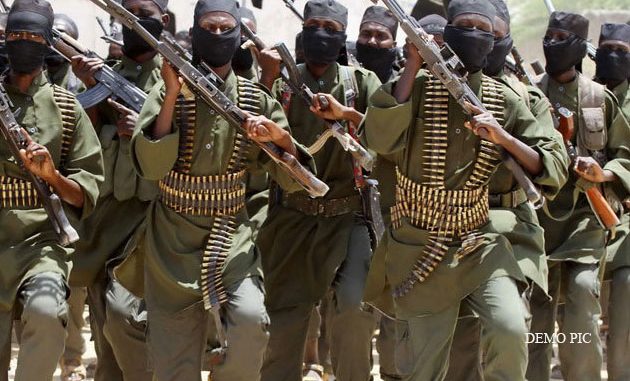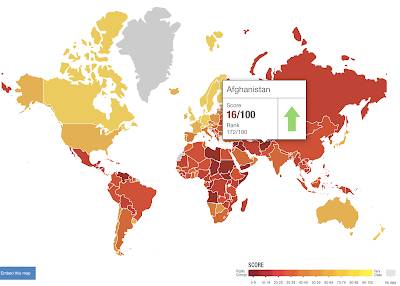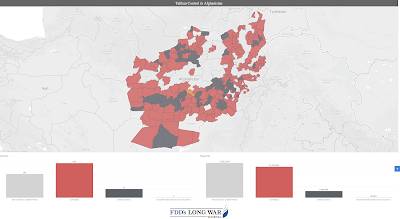
The Special Inspector General for Afghanistan Reconstruction or SIGAR just released the third edition of its High-Risk List to the 116th Congress of the United States and the Secretaries of both State and Defense. In this report, SIGAR identifies the most serious threats to the American government's $132 billion reconstruction efforts in Afghanistan. This information is of particular interest and importance given that negotiations are currently underway to end the United States' involvement in Afghanistan, involvement that began on October 7, 2001, making this the longest military engagement in American history.
The report opens with this rather sobering summary of the past, present and future in Afghanistan:
"The $132 billion appropriated since 2002 for Afghanistan’s reconstruction has been used to train and equip Afghan security forces, strengthen government institutions, promote the rule of law, protect women’s rights, improve health and education, and stimulate economic development, among other objectives.
Yet the gains from our nation’s investment in Afghanistan’s reconstruction face multiple threats: continued insecurity, endemic corruption, weak Afghan institutions, the insidious impact of the narcotics trade, and inadequate coordination and oversight by donors.
While an equitable and sustainable peace agreement in Afghanistan could end much of the violence that presents the greatest threat to the reconstruction effort, a peace agreement may bring its own set of challenges to sustaining the gains that the United States, its Coalition partners, and the Afghan government have achieved over that time." (my bold)
Here is a listing of the eight current high risk areas:
1.) Widespread Insecurity – whether a peace plan is put into place or not, Afghanistan is likely to continue to experience multiple violent extremist organizations. The Afghan National Defense and Security Forces require annual funding of between $4 billion and $5 billion to remain viable.
2.) Underdeveloped Civil Policing Capability – The United States has spent more effort reconstructing the Afghan National Army than on the Afghan National Police meaning that there is no strategy for a competent civil police force backed by rule of law. Sustaining a national police force will require significant foreign funding.
3.) Endemic Corruption – Corruption is endemic and forms a significant threat to the Afghan government. This means that reconstruction programs will continue to be subverted and are likely to fail. Here is a graphic from Transparency International showing where Afghanistan lies on the global spectrum when it comes to corruption:
Afghanistan has the world's 9th lowest corruption score as shown on this list:
4.) Sluggish Economic Growth – Afghanistan's legal economy is sluggish and there are numerous barriers to further economic growth.
5.) Illicit Narcotics Trade – Afghanistan remains the world's largest producer of opium poppies and had the two highest years of cultivation in 2017 and 2018. Funds from the illicit drug trade fund the Taliban, corrupt members of the Afghan government, military and police and also employ 600,000 Afghanis.
6.) Threats to Women's Rights – More than $1 billion has been spent since 2002 to advance the status of women in Afghanistan but gains made so far are fragile, particularly in rural areas, and are likely to be unprotected should the Taliban be part of a peace settlement.
7.) Challenge of Reintegration – The social, economic and political reintegration of tens of thousands of former fighters back into Afghan society will be difficult, particularly in light of the nation's weak economy and political uncertainty and distrust.
8.) Restricted Oversight – If a peace settlement includes reductions in foreign personnel providing oversight on foreign funded programs, problems in the nation will only increase thanks to high levels of corruption.
Let's look at some examples of where U.S. tax dollars have been spent in Afghanistan. Since 2001, an estimated $780 billion has been appropriated for Afghanistan including war funding, diplomatic and consular programs, military and embassy construction projects etcetera. Of this $738 billion or 95 percent of the total was obligated by the Department of Defense. Reconstruction costs make up 15 percent of total U.S. funds obligated for Afghanistan since 2001 and are broken down as follows:
1.) Security – $83.1 billion (63 percent of the total) to build up Afghan military and police. In fiscal 2019, 82 percent of the funds appropriated for Afghanistan reconstruction were spent on assisting the security sector. The "success" of this program can be put into perspective with this map showing the areas of Afghanistan that are under control of the Taliban, the original target of Operation Enduring Freedom:
2.) Governance and Economic Development – $33.9 billion (26 percent of the total). In fiscal 2018, only 12 percent of the funds appropriated for Afghanistan reconstruction were spent on improving the nation's economy.
3.) Counternarcotics Programs – $8.9 billion (7 percent of the total).
The remaining 4 percent of reconstruction funds have been spent to support civilian operations, humanitarian initiatives and in combating society-wide corruption.
Let's close by looking at a few quotes from the report that show just how dire the situation in Afghanistan still is nearly 18 years after Operation Enduring Freedom began and how unlikely a peace settlement is likely to change the situation on the ground:
1.) Failure to successfully reintegrate an estimated 60,000 Taliban fighters and their families, and other illegal armed groups, could undermine the successful implementation of any peace agreement.
2.) The opium trade plays a significant role in the Afghan economy and it is difficult to see how a peace accord between the Afghan government and the insurgency would translate into the collapse or contraction of the illicit drug trade. The country requires a growing economy or favorable economic conditions to provide farmers and former insurgents with legitimate employment and a reliable income to replace opium poppy cultivation. The Afghan government also needs to pursue major drug traffickers, which it has not done consistently or successfully. According to the Department of Justice, “certain influential people are above the law.”
3.) Effective policing will require a force that gives citizens the presumption of innocence rather than anticipating and taking preemptive offensive operations against perceived threats. U.S. agencies, such as the Justice Department, currently lack the personnel numbers and para-military strength to accompany Afghan National Police trainees into high-threat districts.
4.) In a post-settlement environment, depending on the terms of an agreement, there may also be the challenge of integrating former Taliban fighters into the national security forces and society. These issues could become more acute should international financial and military support decline sharply before, during, or after peace talks between the Afghan government and the Taliban.
Let's close this sobering view of Afghanistan's future with an excerpt from the prepared remarks given by the the Special Inspector General for Afghanistan Reconstruction, John F. Sopko that accompanied the release of the report:
"If the U.S. reduces its presence in Afghanistan but feels compelled to provide significant financial support for reconstruction, there may be little choice but to provide a greater proportion of funding as on-budget assistance. But if that road is taken, assistance should be conditioned on an independent finding that adequate monitoring mechanisms and internal controls for the Afghan ministry or multilateral trust fund in question are in place.
If those conditions are lacking and assistance is provided anyway, we may as well set the cash ablaze on the streets of Kabul for all the good it will do.
I urge Congress to not just think about how much money should be given, but also to think about how that money will be provided and monitored. If the need for oversight is ignored or sidelined, both the American taxpayer and the Afghan people will suffer, even with a successful peace agreement." (my bold)
At the very least, it appears that 18 years of war has accomplished almost nothing when it comes to meaningful and permanent changes in Afghanistan despite the spending of hundreds of billions of hard-earned taxpayers' dollars.
Click HERE to read more from this author.
You can publish this article on your website as long as you provide a link back to this page.




Be the first to comment